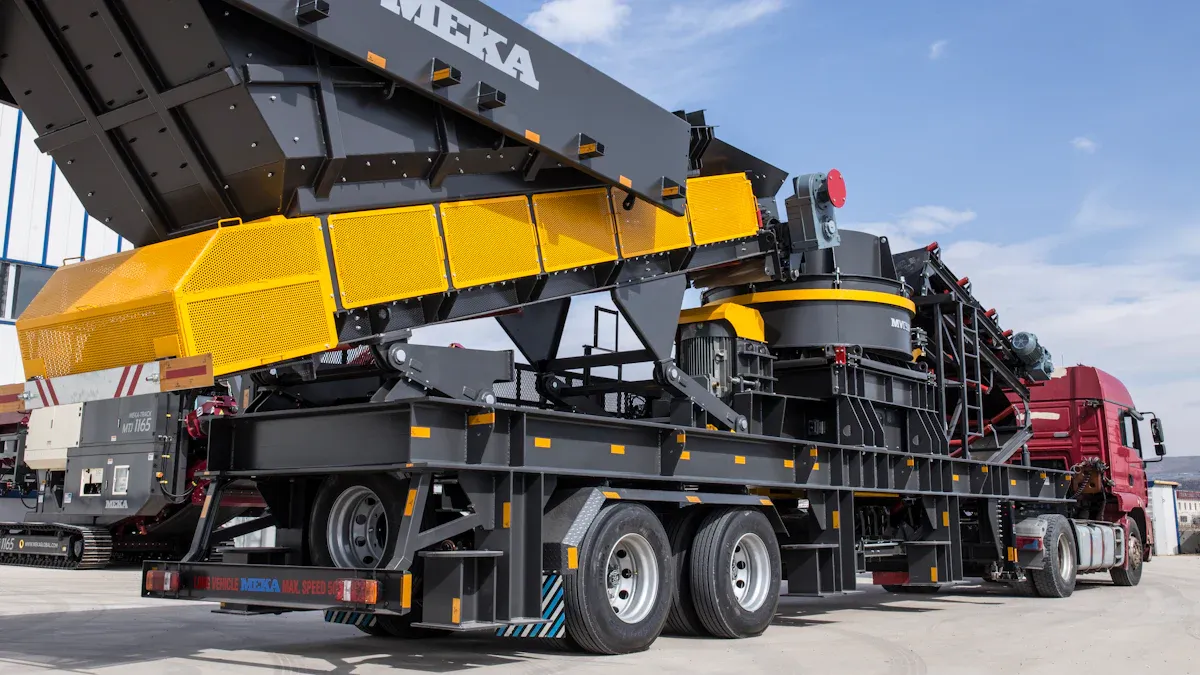
Troubleshooting jaw crusher jaw plate issues is essential for maintaining efficient crusher performance. When problems remain unresolved, they can significantly reduce throughput and increase operating costs. For instance, adjusting the closed-side setting (CSS) of a crusher can drastically alter its output. A wider gap might yield 60 tons per hour (TPH), while a tighter gap could drop production to just 5 TPH. Similarly, material hardness plays a critical role. Crushing granite, with a Mohs hardness of 7, may produce 10 TPH, whereas softer materials like concrete can achieve up to 50 TPH. By addressing jaw plate problems promptly, you can optimize output, minimize wear, and extend the lifespan of your equipment.

Uneven wear on jaw plates is one of the most common problems you may encounter. This issue often arises when the working faces of the jaw crusher plates shift during operation. As a result, the wear becomes concentrated in specific areas, significantly reducing the lifespan of the plates. For instance, the service life of fixed jaw plates can drop from 150 days to just 63 days, while movable jaw plates may only last 150 days instead of 180. This accelerated wear not only increases maintenance costs but also impacts the crusher's performance. Larger discharge particle sizes and inconsistent product quality are direct consequences of uneven wear. To minimize this issue, you should regularly inspect the plates and ensure proper alignment during installation.
Jaw plate breakage and cracks can disrupt your crusher's operation and lead to costly downtime. These issues often occur due to excessive stress on the plates, which may result from crushing overly hard materials or improper crusher settings. Cracks can also develop if the jaw plates are not securely fastened or if the material being processed contains uncrushable objects like metal. To prevent breakage, you should monitor the hardness of the materials being crushed and adjust the crusher settings accordingly. Additionally, always check for loose bolts and remove any foreign objects from the feed material.
Misaligned jaw plates can cause uneven wear and reduce the efficiency of your jaw crusher. This problem typically occurs when the plates are not installed correctly or when the crusher experiences excessive vibrations during operation. Misalignment can lead to increased friction, which accelerates wear and shortens the lifespan of the plates. To address this issue, you should ensure that the jaw plates are properly aligned during installation. Regularly inspect the crusher for signs of vibration and take corrective measures, such as tightening loose components or replacing worn-out parts.
Material build-up on jaw plates is a common issue that can hinder your crusher's performance. This problem occurs when crushed material adheres to the surface of the plates, forming a layer that reduces the crusher's efficiency. Over time, this build-up can lead to uneven wear, increased stress on the machine, and reduced output.
Several factors contribute to material build-up on jaw plates:
- Moisture Content: Wet or sticky materials, such as clay or damp soil, tend to stick to the plates.
- Improper Feed Size: Feeding oversized material can cause blockages, leading to accumulation.
- Low Crushing Force: Insufficient crushing force may fail to dislodge material from the plates.
Ignoring this issue can result in:
- Reduced crushing efficiency and throughput.
- Accelerated wear on jaw plates due to uneven pressure distribution.
- Increased energy consumption as the crusher works harder to process material.
Tip: Regularly inspect the jaw plates for signs of build-up. Early detection can save you from costly repairs and downtime.
You can take several steps to minimize material build-up:
1. Pre-Screen Material: Remove fine particles and sticky materials before feeding them into the crusher.
2. Adjust Crusher Settings: Increase the crushing force or adjust the feed size to prevent blockages.
3. Use Anti-Stick Coatings: Apply specialized coatings to the jaw plates to reduce adhesion.
4. Schedule Cleaning: Regularly clean the jaw plates to remove any accumulated material.
By addressing material build-up promptly, you can maintain optimal crusher performance and extend the life of your jaw plates.
Visual inspection is one of the simplest yet most effective methods to diagnose issues with jaw plates. By closely examining the surface of the jaw crusher plates, you can identify visible defects such as cracks, pits, scratches, or uneven wear. This method also helps you detect corrosion or any signs of improper alignment. For example, if you notice weld spatter or undercutting, it could indicate poor assembly or maintenance practices.
You can also use visual inspection to check the condition of applied coatings on the jaw plates. Uniform coatings without surface imperfections suggest proper application, while irregularities may point to potential problems. Additionally, this method allows you to verify the alignment and fitting of the jaw plates, ensuring they are correctly installed.
Tip: Regular visual inspections save time and money. They provide immediate results without requiring specialized tools, making them a cost-effective diagnostic approach.
Monitoring performance metrics is essential for identifying underlying jaw plate problems. Key indicators, such as excessive wear or changes in the crushing angle, can signal issues that need attention. For instance, when jaw plates lose their tooth profile, the crusher's efficiency drops, leading to a 10-20% reduction in production.
You should also track the condition of the jaw plates throughout their lifecycle. Increased wear not only affects the plates but also impacts the front frame and swing jaw protection. By monitoring these metrics, you can determine the optimal time to rotate or replace the jaw plates, ensuring cost-effectiveness and consistent performance.
Note: Ignoring these metrics can result in production losses and higher maintenance costs. Regular monitoring helps you maintain the efficiency of your jaw crusher.
Understanding the root causes of wear and damage is crucial for effective troubleshooting. Uneven wear on jaw plates often results from misalignment or improper installation. Crushing overly hard materials or feeding oversized rocks into the crusher can also accelerate wear and lead to cracks or breakage.
Material build-up is another common issue. Sticky or wet materials, such as clay, tend to adhere to the jaw plates, causing uneven pressure distribution and increased stress on the machine. This not only reduces the lifespan of the jaw plates but also affects the crusher's overall performance.
To address these issues, you should analyze the type of material being processed and adjust the crusher settings accordingly. Pre-screening materials to remove fines and sticky particles can also help minimize wear. Additionally, ensuring proper alignment during installation reduces the risk of uneven wear and extends the life of the jaw plates.
Tip: Identifying and addressing the root causes of wear and damage early can prevent costly downtime and improve the efficiency of your jaw crusher.
Adjusting the settings of your jaw crusher is one of the most effective ways to address jaw plate issues and improve their wear life. Proper adjustments ensure that the jaw plates wear evenly, reducing the need for frequent replacement and enhancing the crusher's performance.
To start, ensure that the material fed into the crusher is consistent and well-distributed. Uneven feeding can cause concentrated wear on specific areas of the jaw plates, leading to premature damage. Operate the crusher within the manufacturer's recommended parameters for speed and feed settings. This prevents excessive wear and ensures optimal crushing operation. Additionally, maintaining an ideal crushing chamber setting helps distribute wear evenly across the jaw plates.
You should also consider rotating or turning the jaw plates periodically. This practice ensures that wear is evenly distributed, extending the durability of both the fixed jaw plate and the movable jaw plate. Regular lubrication of moving parts is another critical step. It reduces friction, which can otherwise accelerate wear on the jaw crusher plates. Lastly, consult the manufacturer's guidelines for specific recommendations on adjusting settings to maximize the wear life of your jaw plates.
When jaw plates become excessively worn or damaged, replacement is the only solution to restore the crusher's efficiency. Delaying replacement can lead to reduced performance, increased energy consumption, and even damage to other components of the crusher.
Before replacing jaw plates, inspect them thoroughly to determine the extent of wear or damage. Look for signs such as cracks, uneven wear patterns, or loss of the tooth profile. Once you confirm the need for replacement, follow the manufacturer's instructions to ensure proper installation. Always use high-quality two-piece jaw plates that match the specifications of your crusher. Choosing jaw plates made from durable materials, such as manganese steel, can significantly enhance their wear life and durability.
During the replacement process, ensure that the new jaw plates are securely fastened. Loose plates can cause misalignment, leading to uneven wear and reduced efficiency. After installation, test the crusher to verify that it operates smoothly and that the jaw plates are aligned correctly. Regularly monitor the condition of the new plates to identify any issues early and prevent costly downtime.
Proper installation and alignment of jaw plates are crucial for maintaining the efficiency and longevity of your jaw crusher. Misaligned plates can cause uneven wear, increased friction, and reduced crushing efficiency. To avoid these issues, take extra care during the installation process.
Begin by cleaning the mounting surfaces to remove any debris or residue. This ensures a secure fit for the jaw plates. Align the fixed jaw plate and the movable jaw plate precisely according to the manufacturer's specifications. Use appropriate tools to tighten the bolts securely, preventing any movement during operation.
After installation, inspect the alignment by running the crusher at a low speed. Check for any unusual vibrations or noises, which could indicate misalignment. If you notice any issues, stop the crusher immediately and make the necessary adjustments. Regular inspections during operation can help you identify alignment problems early and take corrective action before they escalate.
By ensuring proper installation and alignment, you can minimize wear on the jaw plates, improve the crusher's performance, and extend the wear life of your equipment.
Regular maintenance plays a vital role in extending the life of jaw plates and ensuring your jaw crusher operates efficiently. By following a consistent maintenance schedule, you can prevent costly downtime and reduce the need for frequent replacement of worn components. Here are some essential practices to include in your maintenance routine:
Inspect Jaw Plates Regularly
Frequent inspections help you identify early signs of wear or damage. Look for uneven wear patterns, cracks, or material build-up on the jaw plates. Addressing these issues promptly can prevent further damage and maintain the crusher's performance.
Rotate Jaw Plates to Maximize Wear Life
Rotating jaw plates at the right time ensures even wear and extends their lifespan. The rotation process depends on the type of jaw plates you use. Refer to the table below for specific guidelines:
| Maintenance Practice | Description |
|---|---|
| Rotating one-piece jaw plates | Rotate when wear reaches 30% in the lower area, then again at 90-100% wear in the new lower area. |
| Rotating two-piece jaw plates | Remove worn plates from the bottom, install work-hardened upper dies at the bottom, and new dies at the top. |
Following these rotation practices ensures that the jaw plates wear evenly, reducing the need for premature replacement.
Lubricate Moving Parts
Proper lubrication minimizes friction between moving components, which can otherwise accelerate wear on the jaw plates. Use the manufacturer-recommended lubricants and apply them at regular intervals to keep the crusher running smoothly.
Clean the Crusher After Each Use
Cleaning the crusher prevents material build-up on the jaw plates. Sticky or wet materials can adhere to the plates, causing uneven wear and reducing efficiency. Use a brush or scraper to remove any residue after each operation.
Monitor Crusher Settings
Adjusting the crusher settings periodically ensures optimal performance and even wear on the jaw plates. Check the closed-side setting (CSS) and other parameters to match the material being processed. This practice prevents overloading and extends the life of the jaw plates.
Tip: Keep a detailed maintenance log to track inspections, rotations, and adjustments. This record helps you identify patterns and plan proactive maintenance.
By implementing these regular maintenance practices, you can maximize the wear life of your jaw plates, reduce operating costs, and maintain consistent crusher performance.

Choosing jaw plates made from the right material is essential for extending their wear life and improving crusher performance. Different materials offer varying levels of hardness and durability, which directly impact how long the jaw plates last. For example, materials like 17% Cr White Iron have a low wear rate and high hardness, making them ideal for crushing abrasive materials. On the other hand, Austenitic 304 SS has a high wear rate and low hardness, which may not be suitable for heavy-duty operations.
The table below highlights the comparative benefits of different jaw plate materials:
| Material Type | Wear Rate | Hardness (Brinell) |
|---|---|---|
| Austenitic 304 SS (W316) | High | Low |
| 17% Cr White Iron (W299F) | Low | High |
| Carbide Reinforced Materials | Moderate | Moderate |
| 13% Austenitic Mn Steel (W315) | Moderate | Moderate |
| ASTM A514 Low Alloy Steel (W184) | Moderate | Moderate |
When selecting jaw plates, consider the type of material you process and the operating conditions of your crusher. This ensures you choose a jaw plate material that balances wear resistance and durability.
Optimizing your crusher's operation is key to ensuring even wear on jaw plates. Uneven wear can shorten the lifespan of the plates and reduce the efficiency of your jaw crusher. To prevent this, you should focus on three critical strategies:
Maintain the correct closed-side setting (CSS). This ensures the jaw plates wear evenly and the crusher operates efficiently.
Control the feed size. Feeding material that is too large can cause excessive wear and damage to the plates.
Regularly inspect and replace worn parts. This prevents uneven wear and ensures the crusher continues to perform optimally.
By implementing these strategies, you can maximize the wear life of your jaw plates and maintain consistent crusher performance.
Routine inspections and maintenance are vital for extending the life of jaw plates. Regular checks help you identify early signs of wear or damage, such as cracks or uneven wear patterns. Addressing these issues promptly prevents further damage and reduces downtime.
Create a maintenance schedule that includes tasks like inspecting jaw plates, cleaning the crusher, and lubricating moving parts. For example, cleaning the pl ates after each use prevents material build-up, which can lead to uneven wear. Lubrication reduces friction, ensuring the plates last longer. Additionally, rotating the jaw plates periodically ensures even wear across their surface.
By staying proactive with inspections and maintenance, you can extend the wear life of your jaw plates and keep your crusher running efficiently.
Troubleshooting jaw plates effectively ensures your crusher operates at peak performance. Start by identifying common issues like uneven wear or misalignment. Address these problems through proper installation, regular inspections, and timely replacements. Adjusting crusher settings and rotating jaw plates periodically can also extend their wear life.
Regular maintenance is essential. Inspect jaw plates frequently, clean them after use, and monitor performance metrics. These practices prevent costly downtime and improve efficiency. Proactive measures, such as selecting the right materials and optimizing operations, help you maximize the lifespan of your equipment.
Tip: Staying ahead with maintenance saves money and keeps your crusher running smoothly.
Uneven wear happens when the crusher operates with misaligned plates or inconsistent feeding. Feeding oversized material or running the crusher outside recommended settings also contributes to this issue. Regular inspections and proper alignment prevent uneven wear.
Replace jaw plates when wear reaches 90-100% in critical areas. Monitor wear patterns during routine inspections. Rotating plates at the right time extends their life and delays replacement.
Yes, material build-up increases stress on jaw plates and causes uneven wear. Sticky or wet materials often lead to this problem. Cleaning plates after each use and pre-screening materials help prevent build-up.
Choose jaw plates based on the material you crush. For abrasive materials, use manganese steel or 17% Cr White Iron. These materials offer high durability and wear resistance.
Clean the mounting surfaces before installation. Use proper tools to secure the plates tightly. Run the crusher at low speed to check for vibrations or misalignment. Adjust as needed to ensure proper alignment.
Tip: Regular maintenance and proper installation practices keep your jaw plates in top condition.